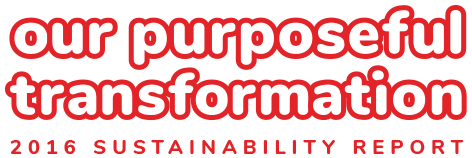natural resources
A Wealth of Uses for URC Waste

Maximizing our resources and minimizing our waste will go a long way to making URC a sustainable company. Our Purposeful Transformation is two-pronged when it comes to waste management: it entails efficient and extended use of our raw materials, and systematic collection and application of alternative functions for waste materials within URC itself. By repurposing our waste and diverting it from the landfill, we are then able to reduce our greenhouse gas emissions.
To date, URC has several initiatives, across our business units (BUs), geared toward the reutilization, recycling, and reprocessing of waste:
URC has identified waste management as a strategic priority and intends to further improve on its existing programs.
FROM GARBAGE PILE TO COMPOST GOLD
Transforming waste into organic fertilizer
Various domestic and international divisions of URC donate bio-waste for composting, to the benefit of planters and farmers. For example, product scraps from BCFG Vietnam such as used tea leaves are reused for composting and donated to partner farms. In the Philippines, domestic waste such as mud press from URC Sugar and Renewables (SURE) is withdrawn by planters and applied to fields as organic fertilizers.
PLASTIC SCRAP REPACKAGED AS NEW
Upcycling regrinds into PET bottles
URC’s commitment to quality usually entails rejecting packaging materials that do not pass inspection, however small the blemish or dent. Added to which, scrap plastics remain after the materials have been cut and folded or shaped into the desired packaging. Rather than dispose of these materials in a landfill, URC has found ways to reincorporate them into new products. For one, URC’s scrap polyethylene terephthalate (PET) material – including bottle rejects – are reground into PET flakes and mixed with virgin PET resin to create new bottles. Only 2-10% reprocessed PET resin is allowed into the mix to maintain the integrity of the bottle.
WASTE CONVERTED INTO RENEWABLE ENERGY
Bagasse and biomass used to generate power
URC AIG collects chicken manure from its layer farm, which is then used to fuel its biogas digester plant in Naic, Cavite to produce 160 kilowatts (kW) of electricity – more than enough to accommodate the power demand of five fully automated, climatecontrolled, and tunnel-ventilated chicken houses. Apart from minimizing waste, the facility is also able to save on power costs of up to Php 6 million annually. In addition, URC AIG uses hog manure to fuel its 400 kW biogas digester plant in San Miguel, Bulacan. The electricity produced by the facility saves the hog farm around Php 14.4 million, annually.
On the other hand, at URC SURE, bagasse or the dry, pulpy residue leftover from the extraction of juice from sugar cane is used as fuel to generate electricity. Currently, the biomass-fired power cogeneration plant in Kabankalan City, Negros Occidental is capable of generating 46 megawatts (MW) of electricity, enough to power the sugar mill operations of URC SURE SONEDCO, and also supply 20 MW to the grid.
Meanwhile, at the URC Distillery, spent wash is recycled during the fermentation process that produces fuel-grade ethanol, and incinerated via the boiler to generate steam and power.
Moving forward, we have identified waste management as a strategic priority, and we intend to further improve on our existing programs. We are motivated by our sincere desire to neutralize any negative impacts our waste generation may have on the environment as a whole, and particularly on the local communities where we operate. We are currently in the process of reviewing our initiatives, and we intend to formalize the interconnected aims of our various divisions. Given that we are already proactive in extending the life cycle of our raw materials and by-products, in time, we expect URC’s concerted efforts to significantly reduce waste. At best, we hope to achieve zero waste status.
Other featured articles in the section


natural resources
Download the complete Natural Resources chapter:
Download Standard Quality[856 kb] Download High Quality
[3.79 mb]